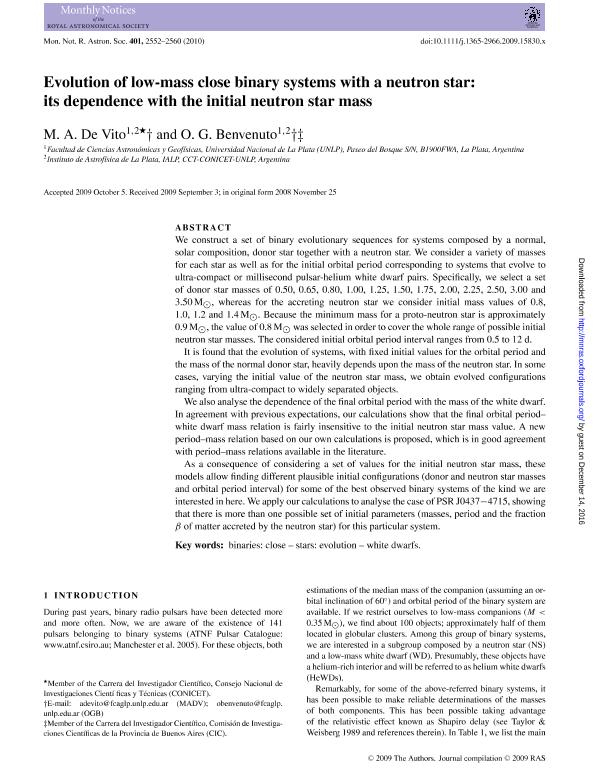Mostrar el registro sencillo del ítem
dc.contributor.author
de Vito, María Alejandra

dc.contributor.author
Benvenuto, Omar Gustavo

dc.date.available
2016-12-14T17:36:58Z
dc.date.issued
2010-02
dc.identifier.citation
de Vito, María Alejandra; Benvenuto, Omar Gustavo; Evolution of low mass close binary systems with a neutron star: its dependence with the initial neutron star mass; Wiley Blackwell Publishing, Inc; Monthly Notices Of The Royal Astronomical Society; 401; 4; 2-2010; 2552-2560
dc.identifier.issn
0035-8711
dc.identifier.uri
http://hdl.handle.net/11336/9393
dc.description.abstract
We construct a set of binary evolutionary sequences for systems composed by a normal, solar composition, donor star together with a neutron star. We consider a variety of masses for each star as well as for the initial orbital period corresponding to systems that evolve to ultra-compact or millisecond pulsar-helium white dwarf pairs. Specifically, we select a set of donor star masses of 0.50, 0.65, 0.80, 1.00, 1.25, 1.50, 1.75, 2.00, 2.25, 2.50, 3.00 and 3.50 M⊙, whereas for the accreting neutron star we consider initial mass values of 0.8, 1.0, 1.2 and 1.4 M⊙. Because the minimum mass for a proto-neutron star is approximately 0.9 M⊙, the value of 0.8 M⊙ was selected in order to cover the whole range of possible initial neutron star masses. The considered initial orbital period interval ranges from 0.5 to 12 d.
It is found that the evolution of systems, with fixed initial values for the orbital period and the mass of the normal donor star, heavily depends upon the mass of the neutron star. In some cases, varying the initial value of the neutron star mass, we obtain evolved configurations ranging from ultra-compact to widely separated objects.
We also analyse the dependence of the final orbital period with the mass of the white dwarf. In agreement with previous expectations, our calculations show that the final orbital period–white dwarf mass relation is fairly insensitive to the initial neutron star mass value. A new period–mass relation based on our own calculations is proposed, which is in good agreement with period–mass relations available in the literature.
As a consequence of considering a set of values for the initial neutron star mass, these models allow finding different plausible initial configurations (donor and neutron star masses and orbital period interval) for some of the best observed binary systems of the kind we are interested in here. We apply our calculations to analyse the case of PSR J0437−4715, showing that there is more than one possible set of initial parameters (masses, period and the fraction β of matter accreted by the neutron star) for this particular system.
dc.format
application/pdf
dc.language.iso
eng
dc.publisher
Wiley Blackwell Publishing, Inc

dc.rights
info:eu-repo/semantics/openAccess
dc.rights.uri
https://creativecommons.org/licenses/by-nc-sa/2.5/ar/
dc.subject
Evolution of Stars
dc.subject
Close Binariesbinaries: Close
dc.subject
White Dwarfs
dc.subject
Stars
dc.subject.classification
Astronomía

dc.subject.classification
Ciencias Físicas

dc.subject.classification
CIENCIAS NATURALES Y EXACTAS

dc.title
Evolution of low mass close binary systems with a neutron star: its dependence with the initial neutron star mass
dc.type
info:eu-repo/semantics/article
dc.type
info:ar-repo/semantics/artículo
dc.type
info:eu-repo/semantics/publishedVersion
dc.date.updated
2016-12-14T12:56:38Z
dc.journal.volume
401
dc.journal.number
4
dc.journal.pagination
2552-2560
dc.journal.pais
Reino Unido

dc.journal.ciudad
Londres
dc.description.fil
Fil: de Vito, María Alejandra. Universidad Nacional de la Plata. Facultad de Ciencias Astronómicas y Geofísicas; Argentina. Consejo Nacional de Investigaciones Científicas y Técnicas. Centro Científico Tecnológico La Plata. Instituto de Astrofísica de La Plata; Argentina
dc.description.fil
Fil: Benvenuto, Omar Gustavo. Consejo Nacional de Investigaciones Científicas y Técnicas. Centro Científico Tecnológico La Plata. Instituto de Astrofísica de La Plata; Argentina. Universidad Nacional de la Plata. Facultad de Ciencias Astronómicas y Geofísicas; Argentina
dc.journal.title
Monthly Notices Of The Royal Astronomical Society

dc.relation.alternativeid
info:eu-repo/semantics/altIdentifier/url/http://mnras.oxfordjournals.org/content/401/4/2552
dc.relation.alternativeid
info:eu-repo/semantics/altIdentifier/doi/http://dx.doi.org/10.1111/j.1365-2966.2009.15830.x
Archivos asociados
